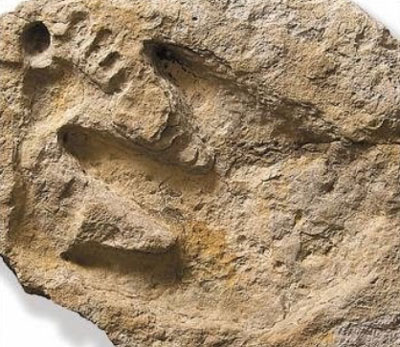The Alvis Delk human-dino footprints artefact
Ancient fossil indicating coexistence, or modern hoax?
Today’s feedback is from Michael G. from U.S.A.
Could you please analyse and comment on the Alvin Delk track in Texas. Thank you.

CMI writer/speaker Dr Tas Walker responded:
Hi Michael,
Thank you for your question about the Alvis Delk artefact. This is a rock originally owned by Alvis Delk which contains what looks like a human footprint overlapping a dinosaur footprint. The story goes that in July 2000, at the Paluxy River in Glen Rose, Texas—an area well known for fossil dinosaur tracks—amateur archaeologist Alvis Delk discovered a slab of rock that contained a well-preserved dinosaur footprint, which he took home and kept as a souvenir. Later, in 2008, he noticed under the dried clay on the rock what appeared to be a human footprint. If this account were accurate, then it would be powerful evidence that dinosaurs and humans lived together in the past, which would have profound implications for ideas about evolution and human origins.
In 2008, Glen Kuban, a vociferous anti-creationist, published an article on the internet entitled “The Alvis Delk print: an alleged human footprint on a loose rock”, an article he updated several times through to 2013. He describes the circumstances around the alleged discovery of the apparent prints, includes images and descriptions, and discusses the morphology (shape) of the prints. Kuban claims that both the dinosaur print and the human print are not genuine but carved or heavily altered from less distinct depressions on the rock.
In April 2015, Ian Juby published an internet article on these prints entitled “Examining the Delk track”. Ian Juby is a creationist and usually careful in his treatment of evidence. He too describes the circumstances around the reported discovery of the apparent prints, includes images and descriptions, and discusses the claims and objections about them. He argues that the fossil footprints are legitimate prints of a human and a dinosaur.
We maintain that there are significant questions surrounding this artefact.
The first problem is that the rock with the tracks was not observed, photographed, and documented in situ. This is referred to as the fossil’s provenance. Recording the provenance involves documenting the context in which it was found. A fossil with a well-documented provenance may be priceless but an identical fossil with no provenance details could be worthless.
The second problem is that only single prints are present, which is a major weakness in the claim. Any footprint claim needs to locate the print within a trackway. A third problem is the long period between allegedly finding the rock with the dinosaur print and observing the ‘human’ print.
Further, the human footprint doesn’t look genuine. It is hard to envisage how a person could leave a track that is so straight from big toe to heel, even if they turned their leg inwards. Then their other toes would not leave such an impression. Also, the print appears to lack an arch, and it looks like the dino stomped in the human track but just pressed inwards without disturbing the human track in any other way. The dino print likewise looks stylised/idealised, and does not closely match genuine dinosaur prints.
The questions these problems raise can’t be answered because the contextual evidence of the rock’s provenance no longer exists. This means that the artefact has no real apologetic value.
Kuban concludes “The Alvis Delk Print is not a convincing human footprint in ancient rock. Its advocates have failed to present the necessary data and details to adequately support their assertions” and “the collective weight of several lines of evidence … point to the strong likelihood that both the ‘human footprint’ and dinosaur track on this loose slab were carved or heavily altered from less distinct depressions.”
I believe there are too many questions surrounding this artefact for it be useful as an apologetic evidence.
We mention claimed human tracks from the Paluxy River area in our article Arguments we think creationists should not use. The relevant section reads:
“Paluxy tracks prove that humans and dinosaurs co-existed.” Some prominent creationist promoters of these tracks have long since withdrawn their support. Some of the allegedly human tracks may be artefacts of erosion of dinosaur tracks obscuring the claw marks. There is a need for properly documented research on the tracks before we would use them to argue the coexistence of humans and dinosaurs. Research to date has not been promising about the tracks, however—see Human and dinosaur fossil footprints in the Upper Cretaceous of North America? But this does not mean that there isn’t good evidence that dinosaurs and humans co-existed—see Q&A: Dinosaurs.
This Alvis Delk artefact has not changed our position on this because there are still too many unanswerable questions about the claim, which makes us sceptical.
All the best,
Dr Tasman Walker
Scientist, Writer, Speaker
Creation Ministries International (Australia)




Readers’ comments
Comments are automatically closed 14 days after publication.